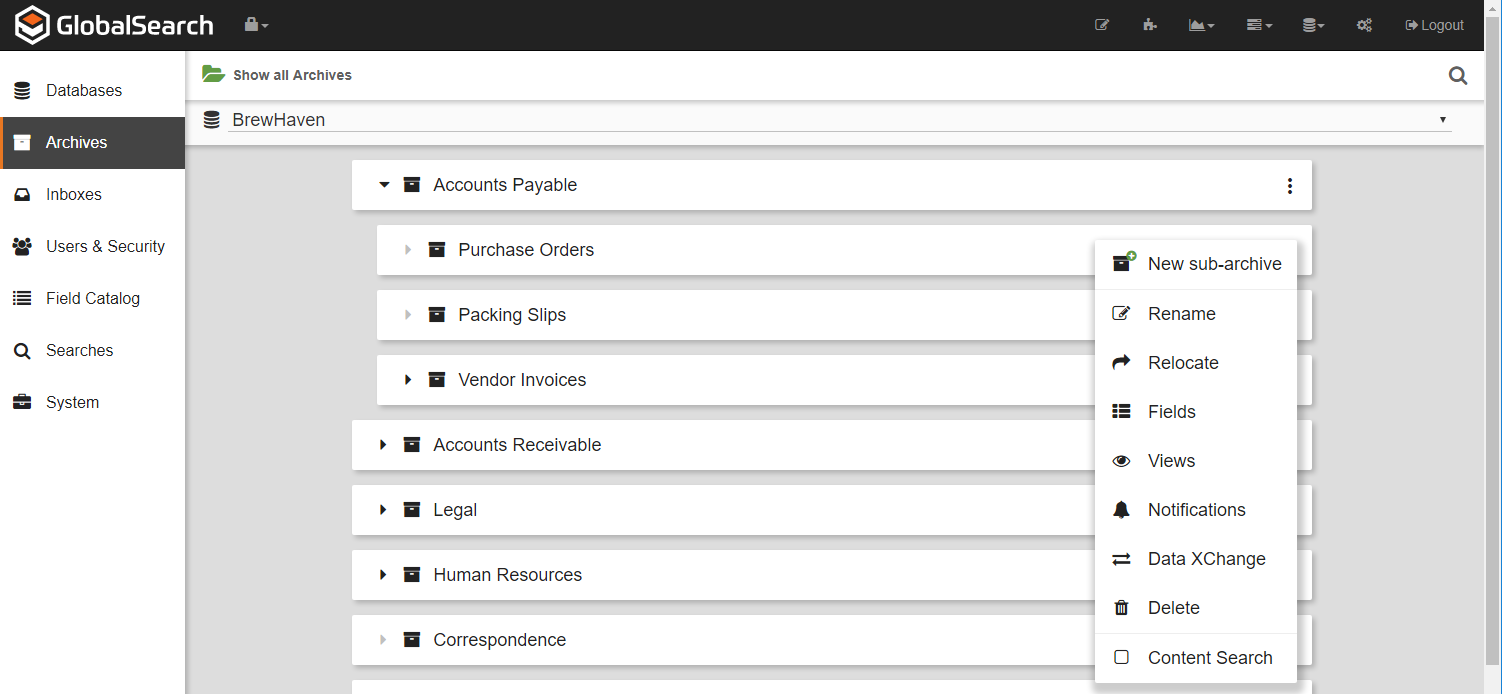Edit Archives
Once created, the Fields, Archive name, email notifications, Views, and Archive path in an Archive can be modified. Versioning and Check In/Check Out can only be created while the Archive is created and cannot be modified. A Browse Search is enabled while the Archive is created. If you add Fields to the Archive later on, be sure to go back to its Browse Search and update it.
- On the GlobalSearch toolbar, in the Administration menu, select Administration.
- In the vertical Administration menu, select Archives. A list of the Archives will appear. Place your mouse pointer over the Archive () icon to view the Archive ID number.
- Click the Expansion (triangle) icon to view any Sub-archives for the Archive.
- Click the More Options () icon for the selected Archive. Refer to the Create Archive - Advanced documentation for details on the following choices:
- To create a new child Archive nested under the selected Archive, select New sub-archive.
- To change the Archive's name, click Rename, enter the new name, and click the Save (checkmark) icon to save the new name or the Cancel (X) icon to keep the old one. Note that changing the Archive name changes the name as shown in the interface. It does not change the name of the associated Archive storage location.
- To change the target path for new files saved into the Archive, click Relocate. In the Relocate dialog, enter a new path (relative to the server) in the Base Path box and click Save.
- To add Fields to, remove Fields from, or reorder fields in the Archive, click Fields. In the Edit Fields dialog:
- Click the Add icon ( + ) on a field in the left column to add it to the Archive.
- Click the Remove icon ( - ) on a field in the right column to remove from the Archive. Removing a Field from an Archive does not remove any data from the document record.
- Click and drag the arrow icon on a field in the right column to reorder the Fields.
Click Save to commit any Field changes, or Cancel to abandon any changes made.
Remember
Adding and removing fields from an archive can impact Searches and how fields are displayed to users in both the Search Results List and the Document Viewer. Be sure to update any affected searches, and be sure to test the fields display as expected to users when making changes. Also consider the impact of changes here to capture and workflow solutions that might release to the archives or rely on the data and searches.
- To edit View Tabs in the Search Results list, or to enable/disable the feature on a search, click Views, modify the settings and click Save.
- To edit email notifications for the Archive Notifications, modify the settings and click Save.
- To allow the contents of text-based documents to be included in a Search, enable Content Search. When selected, two contextual menu items appear:
- To create a new child Archive nested under the selected Archive, select New sub-archive.
- To convert documents to the PDF file type, enable Convert to PDF.
- To rebuild the Content Search index, click Rebuild Index.
- To convert documents to the PDF file type, enable Convert to PDF.
Behind the Scenes
Each Archive stores files in its own specific location. Changing the path to the Archive files changes where new files will write in the future. This does not move already existing files. It creates a new directory structure to match the default base path, or the unique base path, if that is how the Archive was originally configured.
Using the Update Archive feature can be useful if, for example, you have run out of room on the original server and plan to continue to index new documents onto a new server. If you would like old and new files both to reside in a new location, use the Update Archive tool to direct where new files go, move existing files to that new location, then, using SQL Management Studio, modify the pointers for existing documents to indicate their new location. Contact support for assistance on updating document pointers in our SQL databases.

